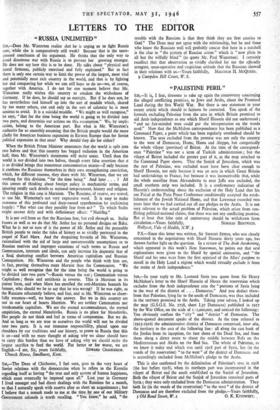Sitt,—In your reply to Mr. Leonard Stein you quote from
Sir Henry McMahon's letter to the Sharif Hussein of Mecca the reservation which excludes from the Arab independence area the "portions of Syria lying to the west of the district of . . . Damascus." And you deduct there- from that Palestine, lying far to the south of Damascus, was thus included in the territory promised to the Arabs. Taking your advice, I looked up the map (G.S.G.S. No. 2758, sheet 1.37 Damascus) published in 1917 by the War Office, on the scale of i : r,000,000, and noticed the following: You obviously confuse the " city " and " district " of Damascus. The above-quoted document speaks of the district. At the time referred to (1915-1916) the administrative district of Damascus comprised, inter alia, the territory to the east of the following line: all along the east bank of the Jordan from its inception, the -east shore of the Dead Sea, and from there aloog a direct route to about the middle between Rafa on the Mediterranean and Akaba on the Red Sea. The whole of Palestine, as we know it today and which was until 1918 part of Syria, lies (in the words of the reservation) "to the west" of the district of Damascus and is accordingly excluded from McMahon's pledge to the Arabs.
This is also confirmed by the delimitation of Palestine's area in 1903 (the last before 1918), when its northern part was incorporated in the vilayet of Beirut and the south established as the Sanjak of Jerusalem. .Both the vilayet of Beirut and the Sanjak of Jerusalem remained parts of Syria ; they were only excluded from the Damascus administration. They both lie (in the words of the reservation) "to the west" of the district of Damascus and are therefore excluded from the pledge.—Yours faithfully,






























 Previous page
Previous page